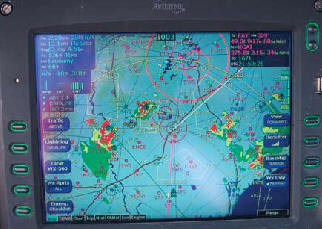|
|||||||||||
|
|
|
|||
|
By |
||||
 |
August 21, 2010 - Datalink is an industry term that many, including pilots, aviation journalists, and manufacturers, use to describe a wide range of equipment and services that all do one basic thing—get data into the cockpit so that the pilot can use it to make decisions.
The technology is
relatively new and evolving so rapidly that we can’t even agree on how
to spell it or define it, let alone use it. In the context of aviation
weather information, datalink (or data link, if you prefer) refers to a
service that uses a satellite antenna mounted on the aircraft, together
with avionics in the cockpit, to receive, process, and display data such
as NEXRAD radar, winds aloft, meteorological reports (METAR) and
terminal aerodrome forecasts (TAF), freezing levels, and cloud coverage.
This graphical and
textual weather information can be displayed on a panel-mounted
multifunction display (MFD) or moving-map GPS, as well as on many
portable GPS devices. If you’ve ever used one of these tools to obtain
weather information during a flight when severe weather was a factor,
you’ve likely experienced the temptation to dodge around the nasty stuff
using the animated color images.
|
|||
| The main problem with using datalink for tactical weather avoidance is that there is a built-in delay between reality and what you see on the screen. | ||||
 |
||||
|
|
||||
|
Develop a Strategy
There I was in
Hilton Head, |
||||
|
I could see the
thunderstorms on the MFD, and I let the briefer know that I had the
benefit of a datalink display. My strategy for avoiding convective
weather during the flight involved booting up the avionics, downloading
the datalink weather, and entering my flight plan route into the GPS
before ever starting the engine or calling Flight Service.
This enabled me to
see the weather overlaid on the MFD map display while I was talking to
the briefer and know immediately if the route I intended to fly would
keep me clear of storms. If not, I could file a different route, start
the engine, contact ground for an IFR clearance, and modify the flight
plan, if needed, all within a few minutes.
The NEXRAD picture
gave me confidence that the first 150 miles or so of the trip would be
clear of weather, with downloaded METARs showing scattered cumulus
clouds between 4,000 and 8,000 feet. I determined from looking at the
moving-map display (which was not yet moving since I was still on the
ground) that the decision point for me to continue as filed or ask ATC
for a reroute around the weather would likely arrive as I approached
Myrtle Beach. With that strategy, I took off into the hazy sky and began
looking out the window for evidence of towering cumulonimbus clouds.
There were plenty
of them. Leveling off in cruise at 7,000 feet, I was above the scattered
layer, but as I expected, by the time I reached
Not only was it an
incredibly beautiful sight, but the NEXRAD on the MFD showed no activity
in that direction, which confirmed what I saw out the left window and
gave me confidence to continue. About 45 minutes later, I landed in
Strategic, Not
Tactical
Pilots must
understand the limitations of any datalink weather product before using
it to make strategic in-flight decisions. For example, in addition to
the inherent processing delay, the collection and delivery of NEXRAD
data from ground stations can be affected by interference from buildings
or terrain.
Most datalink
weather displays will provide some indication of the age of the data.
This is especially important when using a textual METAR to determine
whether a visual or an instrument approach will be required or to even
make an early decision to divert to an alternate airport. With so many datalink weather products available in the general aviation cockpit today, it’s easy for a pilot to get complacent about preflight planning. Just remember that regardless of how many full color displays you have working for you, it’s still your responsibility to obtain a standard briefing—which includes NOTAMs and other critical information— before any flight.
For More Information
Meredith Saini is
a flight instructor and active general aviation pilot in the |
||||||||||||
|
|
||||||||||||
| Other News Stories |
||||||||||||
| ©AvStop
Online Magazine
Contact
Us
Return To News
|
||||||||||||
|





